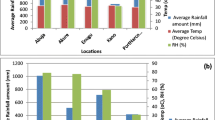Abstract
In this paper, rain characteristics and slant path rain attenuation at 30 and 40 GHz using synthetic storm techniques over seven tropical locations in Nigeria have been presented. The technique can be used to predict the local first-order statistical rain attenuation to mitigate the severe fade experienced at higher frequency bands by employing local rainfall rate statistics. Three years rain rate data at seven tropical and equatorial locations in Nigeria were utilized for the purpose of this work. The predicted statistics are in good agreement with those obtained from the propagation beacon measurement (EUTELSAT W4/W7 satellite-12.245 GHz) It could be observed that at 99.99 % link availability over these locations, the fade margin of higher dB (74 and 81 dB) are required at 30 and 40 GHz frequency bands, respectively. When diurnal variation was observed for four time intervals: 00:00–06:00, 06:00–12:00, 12:00–18:00, and 18:00–24:00, there is a variation of the fade margin over the hours of the day. The overall results will be needed for an acceptable planning that can effectively reduce the fade margin to a very low value for an optimum data communication over the studied locations.








Similar content being viewed by others
References
Adimula IA, Falaiye OA, Willoughby AA (2005) Effects of rain on microwave and satellite communications in equatorial and tropical regions. Niger J Phys 17:66–71
Ajayi GO, Feng S, Radicella SM, Reddy BM (eds) (1996) Handbook on radio propagation related to satellite communication in tropical and subtropical countries. ICTP, Trieste, pp 7–14
Ajewole MO, Kolawole LB, Ajayi GO (1999) Theoretical study of the effect of different types of tropical rainfall on microwave and millimetre-wave propagation. Radio Sci 34(5):1103–1124
Das S, Maitra A, Shukla AK (2013) Diurnal variation of slant path Ka-band rain attenuation at four tropical locations in India. Indian J Radio Space Phys 42:34–41
Drufuca G (1974) Rain attenuation statistics for frequencies above 10 GHz from rain gauge observations. J Resc Atmos 1–2:399–411
ITU-R P. 311–12 (2005) Acquisition, presentation and analysis of data in studies of tropospheric propagation. International Telecommunication Union, Geneva Switzerland
ITU-R P.838-3 (2005) “Specific attenuation model for rain for use in prediction methods”, Recommendation P, ITU-R Ser., International Telecommunication Union, Geneva, Switzerland
ITU-R P.839-3 (2012) Rain height Model for prediction methods Recommendation P, ITU-R Ser., International Telecommunication Union, Geneva, Switzerland
ITU-R. Rec. PN.837-5 (2007) Characteristics of precipitation for propagation modeling. International Telecommunication Union, Geneva Switzerland
Kanellopoulos J, Kafetzia P (1986) Comparison of the synthetic storm technique with a convectional rain attenuation prediction model. IEEE Antennas Propag 34:713
Kheirallah HN, Segal B, Olsen RL (1980) Application of synthetic storm data to evaluate simpler techniques for predicting rain attenuation statistics. Annales des Télécommunications 35:456
Kumar LS, Lee YH, Ong JT (2010) Truncated gamma drop size distribution models for rain attenuation in Singapore. IEEE Trans Antennas Propag 58(4):1325–1335
Lam HY, Din J, Luini L, Panagopoulos AD, Capsoni C (2011) Analysis of raindrop size distribution characteristics in Malaysia for rain attenuation prediction”, 2011 XXXth URSI General Assembly and scientific symposium, 1–4
Maggiori D (1981) Computed transmission through rain in the 1–400 GHz frequency range for spherical and elliptical drops and any polarization. Alta freq (Italy) 50:262
Mandeep JS (2011) Comparison of rain rate models for equatorial climate in South East Asia. Geofizika 28(2):265–274
Matricciani E (1996) Physical Mathematics model of the dynamics of rain attenuation based on rain rate time series and a two layer vertical structure of precipitation. Radio Sci 31(281):1996
Matricciani E (2008) Global formulation of the synthetic storm technique to calculate rain attenuation only from rain rate probability distributions. Antennas and Propagation Society International Symposium, 2008. AP-S 2008. IEEE. doi:10.1109/APS.2008.4619006
Matricciani E, Riva C, Castanet L (2006) Performance of the synthetic storm technique in a low elevation 5A slant path at 44.5 GHz in French Pyrenees”, First European conf on Antenna and propag EUCAP. doi:10.1109/EUCAP.2006.4584768
Ojo JS (2011) Rain rate statistics and fade distributions at Ka- and Ku band frequencies for microwave propagation in the tropical locations. Niger J Space Res 10:72–80
Ojo, J. S and Falodun S.E. (2012): NECOP Propagation Experiment: Rain-rate distributions observations and prediction model comparisons”. Int J Antennas Propag, doi:10.1155/2012/913596, 4 pages, 2012.
Ojo JS, Ajewole MO, Sarkar SK (2008) Rain rate and rain attenuation prediction for satellite communication in Ku and Ka bands over Nigeria. Prog Electromagn Res B 5:207–223
Ojo JS, Ajewole MO, Emiliani LD (2009) One-minute rain rate contour maps for microwave-communication-system planning in a tropical country Nigeria. IEEE Antennas and Propag Mag 51(5):82–89
Oluleye A (2009) Change detection in rainfall anomalies across climatic zones in Nigeria. J Met Cli Sci 7:6–10
Sanchez-Lago I, Fontan FP, Marino P, Fiebig UC (2007) Validation of the synthetic storm technique as part of a time-series generator for satellite links. IEEE Antennas Wirel Propag Lett 6:372
Yeo JX, Lee YH, Ong JT (2009) Modified ITU-R slant path rain attenuation model for the tropical region, Int. Conf on Comm and Processing ICICS, Macau, Art no 5397706, 2009
Zhou XX, Lee YH, Teong OJ (2010) Effect of diurnal variations of rainfall in satellite systems at Ku and Ka band in Singapore, Asia Pacific microwave conference proceedings, 1950–1953
Acknowledgments
The authors acknowledge the Centre for Basic Space Science of NASRDA, Nigeria, for the provision of the wireless weather stations (NECOP equipment) to each of the sites used for this study. The authors are equally grateful to Universiti Kebangsaan Malaysia for granting one of them (ATA) post-doctoral research fellowship through its Centre for Research in Instrumentation and Management (CRIM) under the project code UKM-MI-OUP-2011.
Author information
Authors and Affiliations
Corresponding author
Rights and permissions
About this article
Cite this article
Ojo, J.S., Adediji, A.T., Mandeep, J.S. et al. Variation of slant path Ka/V-band rain attenuation over seven tropical locations in Nigeria using synthetic storm techniques. Theor Appl Climatol 124, 487–496 (2016). https://doi.org/10.1007/s00704-015-1431-0
Received:
Accepted:
Published:
Issue Date:
DOI: https://doi.org/10.1007/s00704-015-1431-0




